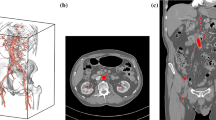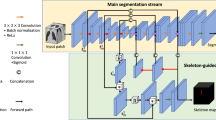Abstract
Purpose
This paper aims to propose a deep learning-based method for abdominal artery segmentation. Blood vessel structure information is essential to diagnosis and treatment. Accurate blood vessel segmentation is critical to preoperative planning. Although deep learning-based methods perform well on large organs, segmenting small organs such as blood vessels is challenging due to complicated branching structures and positions. We propose a 3D deep learning network from a skeleton context-aware perspective to improve segmentation accuracy. In addition, we propose a novel 3D patch generation method which could strengthen the structural diversity of a training data set.
Method
The proposed method segments abdominal arteries from an abdominal computed tomography (CT) volume using a 3D fully convolutional network (FCN). We add two auxiliary tasks to the network to extract the skeleton context of abdominal arteries. In addition, our skeleton-based patch generation (SBPG) method further enables the FCN to segment small arteries. SBPG generates a 3D patch from a CT volume by leveraging artery skeleton information. These methods improve the segmentation accuracies of small arteries.
Results
We used 20 cases of abdominal CT volumes to evaluate the proposed method. The experimental results showed that our method outperformed previous segmentation accuracies. The averaged precision rate, recall rate, and F-measure were 95.5%, 91.0%, and 93.2%, respectively. Compared to a baseline method, our method improved 1.5% the averaged recall rate and 0.7% the averaged F-measure.
Conclusions
We present a skeleton context-aware 3D FCN to segment abdominal arteries from an abdominal CT volume. In addition, we propose a 3D patch generation method. Our fully automated method segmented most of the abdominal artery regions. The method produced competitive segmentation performance compared to previous methods.








Similar content being viewed by others
References
Huang TQ, Qu X, Liu J, Chen S (2014) 3D printing of biomimetic microstructures for cancer cell migration. Biomed Microdevice 16(1):127–132
Reichold J, Stampanoni M, Keller AL, Buck A, Jenny P, Weber B (2009) Vascular graph model to simulate the cerebral blood flow in realistic vascular networks. J Cerebral Blood Flow Metabol 29(8):1429–1443
Karasawa K, Oda M, Kitasaka T, Misawa K, Fujiwara M, Chu C, Zheng G, Rueckert D, Mori K (2017) Multi-atlas pancreas segmentation: atlas selection based on vessel structure. Med Image Anal 39:18–28
Maklad AS, Matsuhiro M, Suzuki H, Kawata Y, Niki N, Shimada M, Iinuma G (2018)Automatic blood vessel based-liver segmentation using the portal phase abdominal CT. In: Medical imaging 2018: computer-aided diagnosis, vol 10575, pp 1057527. International Society for Optics and Photonics
Nezhat C, Childers J, Nezhat F, Nezhat CH, Seidman DS (1997) Major retroperitoneal vascular injury during laparoscopic surgery. Hum Reprod (Oxford, England) 12(3):480–483
Lee S-W, Shinohara H, Matsuki M, Okuda J, Nomura E, Mabuchi H, Nishiguchi K, Takaori K, Narabayashi I, Tanigawa N (2003) Preoperative simulation of vascular anatomy by three-dimensional computed tomography imaging in laparoscopic gastric cancer surgery. J Am Coll Surg 197(6):927–936
Luo H, Yin D, Zhang S, Xiao D, He B, Meng F, Zhang Y, Cai W, He S, Zhang W, Hu Q, Guo H, Liang S, Zhou S, Liu S, Sun L, Guo X, Fang C, Liu L, Jia F (2020) Augmented reality navigation for liver resection with a stereoscopic laparoscope. Comput Methods Programs Biomed 187:105099
Wang S, He K, Nie D, Zhou S, Gao Y, Shen D (2019) CT male pelvic organ segmentation using fully convolutional networks with boundary sensitive representation. Med Image Anal 54:168–178
Chen S, Zhong X, Hu S, Dorn S, Kachelrieß M, Lell M, Maier A (2020) Automatic multi-organ segmentation in dual-energy CT (DECT) with dedicated 3D fully convolutional DECT networks. Med Phys 47(2):552–562
Schlemper J, Oktay O, Schaap M, Heinrich M, Kainz B, Glocker B, Rueckert D (2019) Attention gated networks: learning to leverage salient regions in medical images. Med Image Anal 53:197–207
Wang Z, Meng Y, Weng F, Chen Y, Lu F, Liu X, Hou M, Zhang J (2020) An effective CNN method for fully automated segmenting subcutaneous and visceral adipose tissue on CT scans. Ann Biomed Eng 48(1):312–328
Moccia S, De Momi E, El Hadji S, Mattos LS (2018) Blood vessel segmentation algorithms-review of methods, datasets and evaluation metrics. Comput Methods Programs Biomed 158:71–91
Ciecholewski M, Kassjański M (2021) Computational methods for liver vessel segmentation in medical imaging: a review. Sensors 21(6):2027
Lamy J, Merveille O, Kerautret B, Passat N, Vacavant A (2021) Vesselness filters: A survey with benchmarks applied to liver imaging. In: 2020 25th international conference on pattern recognition (ICPR), pp 3528–3535. IEEE
Jin Q, Meng Z, Pham TD, Chen Q, Wei L, Su R (2019) DUNet: a deformable network for retinal vessel segmentation. Knowl-Based Syst 178:149–162
Wang B, Qiu S, He H (2019) Dual encoding U-Net for retinal vessel segmentation. In: International conference on medical image computing and computer-assisted intervention, pp 84–92. Springer
Wu Y, Xia Y, Song Y, Zhang D, Liu D, Zhang C, Cai W (2019) Vessel-Net: retinal vessel segmentation under multi-path supervision. In: International conference on medical image computing and computer-assisted intervention, pp 264–272. Springer
Samuel PM, Veeramalai T (2021) VSSC Net: vessel specific skip chain convolutional network for blood vessel segmentation. Comput Methods Programs Biomed 198:105769
Xiao X, Lian S, Luo Z, Li S (2018) Weighted res-unet for high-quality retina vessel segmentation. In: 2018 9th international conference on information technology in medicine and education (ITME), pp 327–331. IEEE
Wang W, Zhong J, Wu H, Wen Z, Qin J (2020) RVSeg-Net: an efficient feature pyramid cascade network for retinal vessel segmentation. Lecture Notes in Computer Science, vol 12265, pp 796–805. Springer
Guo C, Szemenyei M, Yi Y, Wang W, Chen B, Fan C (2021) Sa-UNet: spatial attention U-Net for retinal vessel segmentation. In: 2020 25th international conference on pattern recognition (ICPR), pp 1236–1242. IEEE
Wu H, Wang W, Zhong J, Lei B, Wen Z, Qin J (2021) SCS-Net: a scale and context sensitive network for retinal vessel segmentation. Med Image Anal 70:102025
Atli I, Gedik OS (2021) Sine-Net: a fully convolutional deep learning architecture for retinal blood vessel segmentation. Int J Eng Sci Technol 24(2):271–283
Lei T, Wang R, Zhang Y, Wan Y, Liu C, Nandi AK (2021) DefED-Net: deformable encoder-decoder network for liver and liver tumor segmentation. IEEE Trans Radiat Plasma Med Sci 6(1):68–78
Huang Q, Sun J, Ding H, Wang X, Wang G (2018) Robust liver vessel extraction using 3D U-Net with variant dice loss function. Comput Biol Med 101:153–162
Zeng Y, Liao S, Tang P, Zhao Y, Liao M, Chen Y, Liang Y (2018) Automatic liver vessel segmentation using 3D region growing and hybrid active contour model. Comput Biol Med 97:63–73
Lee S-H, Lee S (2015) Adaptive Kalman snake for semi-autonomous 3D vessel tracking. Comput Methods Programs Biomed 122(1):56–75
Tie J, Peng H, Zhou J (2021) MRI brain tumor segmentation using 3D U-Net with dense encoder blocks and residual decoder blocks. Comput Model Eng Sci 128(2):427–445
Cui H, Liu X, Huang N (2019) Pulmonary vessel segmentation based on orthogonal fused U-Net++ of chest CT images. In: International conference on medical image computing and computer-assisted intervention, pp 293–300. Springer
Chen L, Xie Y, Sun J, Balu N, Mossa-Basha M, Pimentel K, Hatsukami, TS, Hwang, J-N, Yuan C (2017) 3d intracranial artery segmentation using a convolutional autoencoder. In: 2017 IEEE international conference on bioinformatics and biomedicine (BIBM), pp 714–717. IEEE
Hesamian MH, Jia W, He X, Kennedy P (2019) Deep learning techniques for medical image segmentation: achievements and challenges. J Digit Imaging 32(4):582–596
Nasalwai N, Punn NS, Sonbhadra SK, Agarwal S (2021) Addressing the class imbalance problem in medical image segmentation via accelerated tversky loss function. In: Pacific-Asia conference on knowledge discovery and data mining, pp 390–402. Springer
Li Z, Kamnitsas K, Glocker B (2020) Analyzing overfitting under class imbalance in neural networks for image segmentation. IEEE Trans Med Imaging 40(3):1065–1077
Zhou T, Ruan S, Canu S (2019) A review: deep learning for medical image segmentation using multi-modality fusion. Array 3:100004
Oda M, Roth HR, Kitasaka T, Misawa K, Fujiwara M, Mori K (2019) Abdominal artery segmentation method from CT volumes using fully convolutional neural network. Int J Comput Assist Radiol Surg 14(12):2069–2081
Lee T-C, Kashyap RL, Chu C-N (1994) Building skeleton models via 3-D medial surface axis thinning algorithms. CVGIP Gr Models Image Process 56(6):462–478
Navarro F, Shit S, Ezhov I, Paetzold J, Gafita A, Peeken JC, Combs SE, Menze, BH (2019) Shape-aware complementary-task learning for multi-organ segmentation. In: International workshop on machine learning in medical imaging, pp 620–627. Springer
Ronneberger O, Fischer P, Brox T (2015) U-Net: Convolutional networks for biomedical image segmentation. In: International conference on medical image computing and computer-assisted intervention, pp 234–241. Springer
Çiçek Ö, Abdulkadir A, Lienkamp SS, Brox T, Ronneberger O (2016) 3D U-Net: learning dense volumetric segmentation from sparse annotation. In: International conference on medical image computing and computer-assisted intervention, pp 424–432. Springer
Lin L, Wang Z, Wu J, Huang Y, Lyu J, Cheng P, Wu J, Tang X (2021) BSDA-Net: a boundary shape and distance aware joint learning framework for segmenting and classifying OCTA images. In: International conference on medical image computing and computer-assisted intervention, pp 65–75. Springer
Yu W, Fang B, Liu Y, Gao M, Zheng S, Wang Y (2019) Liver vessels segmentation based on 3D residual U-Net. In: 2019 IEEE international conference on image processing (ICIP), pp 250–254. IEEE
Milletari F, Navab N, Ahmadi S-A (2016) V-Net: fully convolutional neural networks for volumetric medical image segmentation. In: 2016 Fourth international conference on 3D vision (3DV), pp 565–571. IEEE
Acknowledgements
This work were funded by grants from JSPS KAKENHI (26108006, 26560255, 17H00867, 21K19898), the JST CREST (JPMJCR20D5), and the JSPS Bilateral Joint Research Project.
Author information
Authors and Affiliations
Corresponding authors
Ethics declarations
Conflict of interest
The authors declare that they have no conflict of interest.
Ethical approval
This study was approved by the institutional review boards of Nagoya University and the Aichi Cancer Center Hospital.
Additional information
Publisher's Note
Springer Nature remains neutral with regard to jurisdictional claims in published maps and institutional affiliations.
Supplementary Information
Below is the link to the electronic supplementary material.
Rights and permissions
Springer Nature or its licensor holds exclusive rights to this article under a publishing agreement with the author(s) or other rightsholder(s); author self-archiving of the accepted manuscript version of this article is solely governed by the terms of such publishing agreement and applicable law.
About this article
Cite this article
Zhu, R., Oda, M., Hayashi, Y. et al. A skeleton context-aware 3D fully convolutional network for abdominal artery segmentation. Int J CARS 18, 461–472 (2023). https://doi.org/10.1007/s11548-022-02767-0
Received:
Accepted:
Published:
Issue Date:
DOI: https://doi.org/10.1007/s11548-022-02767-0




